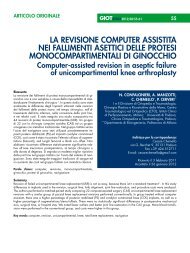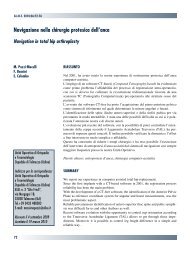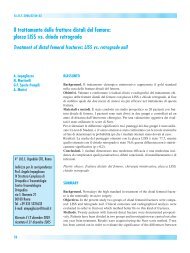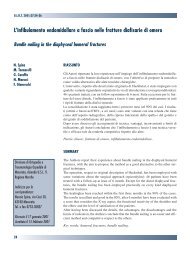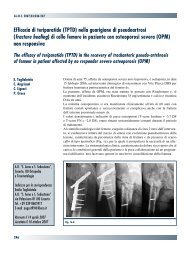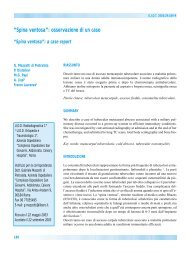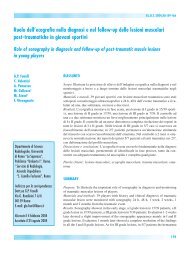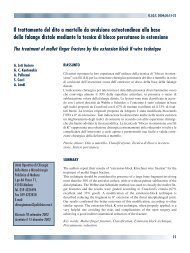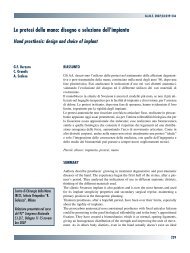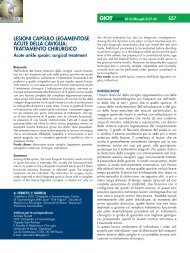30845 Suppl Giot.pdf - Giornale Italiano di Ortopedia e Traumatologia
30845 Suppl Giot.pdf - Giornale Italiano di Ortopedia e Traumatologia
30845 Suppl Giot.pdf - Giornale Italiano di Ortopedia e Traumatologia
Create successful ePaper yourself
Turn your PDF publications into a flip-book with our unique Google optimized e-Paper software.
dback risulta <strong>di</strong> fondamentale importanza nel migliorare la qualità<br />
del controllo e nell’incorporazione della protesi stessa nello schema<br />
corporeo del suo utilizzatore. L’esercizio nel controllo della<br />
mano robotica e nella percezione sensoriale ha prodotto una normalizzazione<br />
delle mappe in corteccia motoria che prima dell’impianto<br />
presentavano una abnorme e asimmetrica ipereccitabilità<br />
nell’emisfero cui compete il moncherino e un miglioramento<br />
della sindrome da arto fantasma, con un progressivo ritorno ad<br />
una percezione più fisiologica del fantasma dell’arto perso. Questi<br />
miglioramenti sono spariti a 3 mesi <strong>di</strong> follow-up dall’espianto<br />
degli elettro<strong>di</strong>. In linea con recenti affermazioni sull’applicazione<br />
<strong>di</strong> interfacce neurali in neuro riabilitazione 9 28 29 questo lavoro<br />
<strong>di</strong>mostra che un sistema protesico con interfaccia neurale caratterizzato<br />
da una elevata interattività col suo utilizzatore può essere<br />
considerato uno strumento neuroriabilitativo, perché in grado <strong>di</strong><br />
indurre una riduzione della neuro plasticità aberrante e dei suoi<br />
effetti negativi.<br />
rINGrazIaMENTI<br />
Questo stu<strong>di</strong>o è stato parzialmente finanziato dalla Commissione<br />
della Comunità Europea nell’ambito dei progetti NEUROBOTICS<br />
(Contract No. FP6-IST-001917 – The fusion of NEUROscience and<br />
roBOTICS) e TIME (Contract No.: FP7-ICT-224012 – Transverse,<br />
Intrafascicular Multichannel Electrode system for induction of sensation<br />
and treatment of phantom limb pain in amputees). Gli autori<br />
ringraziano caldamente il soggetto volontario per aver donato il suo<br />
tempo partecipando ad ogni fase del suddetto protocollo.<br />
Si ringraziano V. Denaro e L. Denaro per gli aspetti microchirurgici,<br />
A. Benvenuto, C. Cipriani, P. Dario, F. Ferreri, E. Guglielmelli, S.<br />
Micera, C. Porcaro, J. Rigosa, M. Tombini, L. Rossini, F. Zappaso<strong>di</strong><br />
per la raccolta dati e le analisi dei segnali EEG, ENG e TMS.<br />
BIBLIOGraFIa<br />
1 Micera S, Carrozza M, Beccai L, et al. Hybrid bionic systems for the<br />
replacement of hand function. IEEE Procee<strong>di</strong>ngs 2006;94:1752-62.<br />
2 Tonet O, Marinelli M, Citi L, et al. Defining brain-machine interface<br />
applications by matching interface performance with device requirements. J<br />
Neurosci Methods 2007.<br />
3 Calford MB, Tweedale R. Imme<strong>di</strong>ate and chronic changes in responses<br />
of somatosensory cortex in adult flying-fox after <strong>di</strong>git amputation. Nature<br />
1988;332:446-8.<br />
4 Florence SL, Kaas JH. Large-scale reorganization at multiple levels of<br />
the somatosensory pathway follows therapeutic amputation of the hand in<br />
monkeys. J Neurosci 1995;15:8083-95.<br />
5 Merzenich MM, Nelson RJ, Stryker MP, et al. Somatosensory cortical<br />
map changes following <strong>di</strong>git amputation in adult monkeys. J Comp Neurol<br />
1984;224:591-605.<br />
6 Mackert BM, Sappok T, Grusser S, et al. The eloquence of silent<br />
cortex: analysis of afferent input to deafferented cortex in arm amputees.<br />
Neuroreport 2003;14:409-12.<br />
7 Mercier C, Reilly KT, Vargas CD, et al. Mapping phantom movement<br />
representations in the motor cortex of amputees. Brain 2006;129:2202-10.<br />
P.M. rossini, G. Di Pino<br />
8 Reilly KT, Mercier C, Schieber MH, et al. Persistent hand motor commands<br />
in the amputees’ brain. Brain 2006;129:2211-23.<br />
9 Di Pino G, Guglielmelli E, Rossini PM. Neuroplasticity in amputees: main<br />
implications on bi<strong>di</strong>rectional interfacing of cybernetic hand prostheses.<br />
Prog Neurobiol 2009;88:114-26.<br />
10 Kuiken TA, Marasco PD, Lock BA, et al. Re<strong>di</strong>rection of cutaneous<br />
sensation from the hand to the chest skin of human amputees with targeted<br />
reinnervation. Proc Natl Acad Sci U S A. 2007;104:20061-6.<br />
11 Kuiken TA, Li G, Lock BA, et al. Targeted muscle reinnervation for<br />
real-time myoelectric control of multifunction artificial arms. JAMA<br />
2009;301:619-28.<br />
12 Dhillon GS, Lawrence SM, Hutchinson DT, et al. Residual function in<br />
peripheral nerve stumps of amputees: implications for neural control of<br />
artificial limbs. J Hand Surg [Am] 2004;29:605-15; <strong>di</strong>scussion 16-8.<br />
13 Jia X, Koenig MA, Zhang X, et al. Residual motor signal in long-term<br />
human severed peripheral nerves and feasibility of neural signal-controlled<br />
artificial limb. J Hand Surg [Am].2007;32:657-66.<br />
14 Navarro X, Krueger TB, Lago N, et al. A critical review of interfaces with<br />
the peripheral nervous system for the control of neuroprostheses and hybrid<br />
bionic systems. J Peripher Nerv Syst 2005;10:229-58.<br />
15 Stieglitz T, Schuettler M, Koch KP. Implantable biome<strong>di</strong>cal microsystems<br />
for neural prostheses. IEEE Eng Med Biol Mag 2005;24:58-65.<br />
16 Tesfayesus W, Durand DM. Blind source separation of peripheral nerve<br />
recor<strong>di</strong>ngs. J Neural Eng 200;4:S157-67.<br />
17 Micera S, Navarro X, Carpaneto J, et al. On the use of longitu<strong>di</strong>nal intrafascicular<br />
peripheral interfaces for the control of cybernetic hand prostheses in amputees.<br />
IEEE Trans Neural Syst Rehabil Eng 2008;16:453-72.<br />
18 Hoffmann KP, Koch KP, Doerge T, et al. New technologies in manufacturing<br />
of <strong>di</strong>fferent implantable microelectrodes as an interface to the peripheral<br />
nervous system. IEEE/RAS-EMBS International Conference on Biome<strong>di</strong>cal<br />
Robotics and Biomechatronics (BioRob). Pisa, Italy, 2006. p. 414-9.<br />
19 Citi L, Carpaneto J, Yoshida K, et al. On the use of wavelet denoising and<br />
spike sorting techniques to process electroneurographic signals recorded<br />
using intraneural electrodes. J Neurosci Methods 2008;172:294-302.<br />
20 Lago N, Yoshida K, Koch KP, Navarro X. Assessment of biocompatibility<br />
of chronically implanted polyimide and platinum intrafascicular electrodes.<br />
IEEE Trans Biomed Eng 2007;54:281-90.<br />
21 Flor H, Elbert T, Knecht S, et al. Phantom-limb pain as a perceptual<br />
correlate of cortical reorganization following arm amputation. Nature<br />
1995;375:482-4.<br />
22 Grusser SM, Winter C, Muhlnickel W, et al. The relationship of perceptual<br />
phenomena and cortical reorganization in upper extremity amputees.<br />
Neuroscience 2001;102:263-72.<br />
23 Rossini PM, Micera S, Benvenuto A, et al. Double nerve intraneural<br />
interface implant on a human amputee for robotic hand control. Clin<br />
Neurophysiol 2010;121:777-83.<br />
24 Carrozza MC, Cappiello G, Micera S, et al. Design of a cybernetic hand for<br />
perception and action. Biol Cybern 2006;95:629-44.<br />
25 Rossini PM, Barker AT, Berardelli A, et al. Non-invasive electrical and<br />
magnetic stimulation of the brain, spinal cord and roots: basic principles<br />
and procedures for routine clinical application. Report of an IFCN<br />
committee. Electroencephalogr Clin Neurophysiol 1994;91:79-92.<br />
26 Dhillon GS, Horch KW. Direct neural sensory feedback and control of a<br />
prosthetic arm. IEEE Trans Neural Syst Rehabil Eng 2005;13:468-72.<br />
27 Di Pino G. Bi<strong>di</strong>rectional peripheral-nerves interfaces for hand prosthesis<br />
control. In human validation and analysis of the induced neuroplasticity and<br />
of the foreign body reaction. PhD Thesis. Rome: Campus Bio Me<strong>di</strong>co; 2010.<br />
28 Dobkin BH. Brain-computer interface technology as a tool to augment<br />
plasticity and outcomes for neurological rehabilitation. J Physiol<br />
2007;579:637-42.<br />
29 Daly JJ, Wolpaw JR. Brain-computer interfaces in neurological<br />
rehabilitation. Lancet Neurol 2008;7:1032-43.<br />
S317



